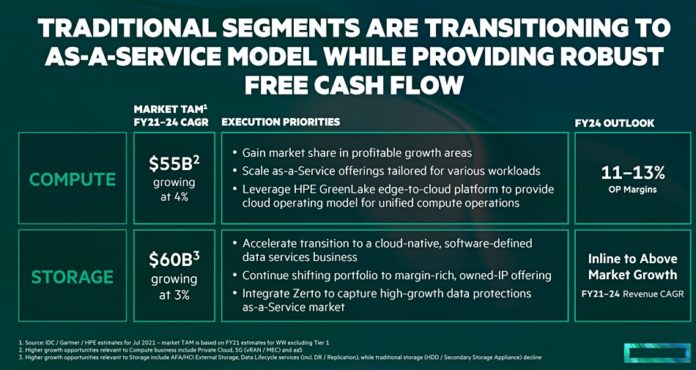HPE’s GreenLake edge-to-cloud and service-led strategy includes more HP-owned intellectual storage property and that implies limiting its software partnerships.
HPE ran a virtual Security Analysts meeting giving details of the company’s strategy — how it’s going to set up clear clear GreenLake water between itself and its competitors. We took a dive into this to see what it means for its storage products, and found a move to own more of its own storage IP.

CEO Antonio Neri said HPE is focussed on three megatrends with new sources of data, new IT architectures, and new insights from data:
- A data explosion at the edge (ROBO and embedded systems);
- Adoption of a cloud-everywhere experience, meaning IT-as-a-service, elasticity, subscription/pay-for-use and cloud-native software;
- Adoption of data analytics.
HPE says it has an edge-to-cloud strategy with its customers needing to control their data assets wherever they are located, make decisions faster and have a unified service delivery across their IT estate.
The set of HPE’s storage products have to adapt to fit into this view of the world. Data has to be stored, moved where needed, and analysed to give customers a better view of their operations and a faster ability to adapt to changes and opportunities. Neri said digital transformation is incomplete without data-first modernisation from edge to cloud. By 2025 some 85 per cent of data will be unstructured, 60 per cent of it will be generated at the edge and 30 per cent of it will be real-time.
Data, he said, is spread across — even trapped in — a sprawl of silos in legacy and hybrid IT infrastructures. The volume of data being generated at edge sites means much of it must be analysed there. It takes too long to move it to the public cloud for analysis and decision-making.
The HPE message is to use its GreenLake offering to free data and work on it where it makes sense.

HPE storage products
If HPE customers buy into this GreenLake edge-to-cloud view of things then they will have an incentive to buy HPE storage products because they fit into the GreenLake scheme.
HPE is building up its capabilities in its edge-to-cloud area by buying companies such as Silver Peak and Zerto, and making strategic investments in others, such as Cohesity and SingleStore.
Neri said the HPE story was being accepted by customers, citing growth in connectivity and compute, in GreenLake revenues and in storage. He said there had been more than 100 per cent year-on-year Primera array revenue growth and more than 140 per cent Nimble dHCI (Disaggregated HCI) revenue growth, both in the first three quarters of HPE’s fiscal 2021. He did not mention SimpliVIty HCI systems though.
He divided HPE’s products into core, growth and AAS (as-a-service) enablers, with the core’s function being cash generation. The core products were compute (ProLiant and Synergy) and storage (Alletra, Primera, Nimble dHCI and Zerto). He said compute was a $55 billion target addressable market growing at four per cent between FY2021 and FY2024. Storage has a $60 billion TAM and a three per cent CAGR.
Growth products encompassed Edge (Aruba, Silver Peak) and HPC and AI (Apollo, Cray, Determined AI) and their function is to generate growth. The AAS enablers are meant to drive AAS adoption and include consumption-driven financing, advisory and professional services.
Ringing the storage changes
The execution priorities for HPE in the storage business are to accelerate the transition to a cloud-native, software-defined data services business, to continue shifting the portfolio to margin-rich, owned-IP offerings, and integrate Zerto to capture the high-growth data protections as-a-Service market.

Up until now HPE has partnered with any serious storage software player that could help it sell servers. Witness its deals with Cloudian, MinIO and Scality in the object storage area and WekaIO in the file area. An example of a shift to HPE’s own storage IP has been seen with the Ezmeral Data Fabric which supports the S3 object API and stores object data.
It does not use MinIO software, which we might have expected given HPE’s previous use of embedded MinIO software in its product offerings, nor Cloudian or Scality software. Instead HPE has developed its own object storage software.
All storage software vendors partnering with HPE facing having the scope of their partnership — and even its existence — put under threat by this owned-IP preference expressed by Neri.








